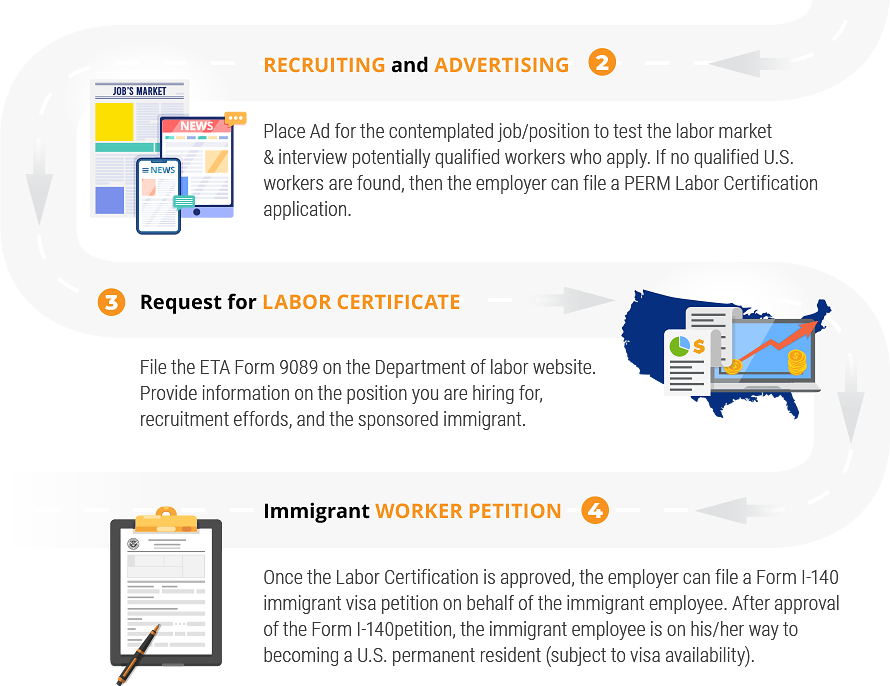Permanent Residency
Every fiscal year (October 1st – September 30th), approximately 140,000 employment-based immigrant visas are made available to qualified applicants under the provisions of U.S. immigration law. Employment based immigrant visas are divided into several preference categories. Certain spouses and children may accompany or follow-to-joinFollow-to-Join is a pathway for family members of eligible green card holders to come to immigrate to the United States employment-based immigrants.
All categories of employment-based immigrant visas are issued in the chronological order in which the petitions were filed until the annual numerical limit for the category is reached. The filing date of a petition becomes the applicant’s priority date. Immigrant visas cannot be issued until an applicant’s priority date is reached. In certain heavily oversubscribed categories, there may be a waiting period of several years before a priority date is reached.
Whether you are relocating an employee or expanding your business into the American market, we are here to help you. We assist businesses and organizations of all sizes that come from various industries and fields.
We help entrepreneurs, scientists, medical professionals, students, entertainers, athletes, and other professionals with their immigration needs. Whether you are seeking to bring in a foreign employee or planning to make a business investment in the American economy, we will be happy to assist you throughout the process.
First-preference category
The first employment based immigration preference category covers “priority workers” divided in 3 groups: (1) Aliens of extraordinary ability; (2) Outstanding professors and researchers; (3) Multi-national executives and managers.
One of the most attractive aspects of the EB-1 category is that the labor certification requirement does not apply. It means that in certain cases applicant does not require sponsoring employer and may petition for himself. This makes the time spent processing an EB-1 application much shorter than for categories that do require a labor certification.
Which Employment-based category is right for you?
Employment based (EB) immigrant visas have many sub-categories. With exception to EB-5 investor visas, employment-based immigration relies on professional skills and qualifications of the applicant. Here are three of the primary EB visa categories:
eb-1, eb-2, eb-3

EB-1: PRIORITY WORKERS
Who qualifies? The 3 subcategories are:

Extraordinary ability
National & International award-winners, experts in art, science, business, or sports

Outstanding professors
& researchers:
Recognized in Academia and/or research

Multinational managers
and executives
of companies operating
in U.S. and abroad
EB-2: PROFESSIONALS
Who qualifies? The 3 subcategories are:

Advanced degree
Master’s or Doctorate

Exceptional ability
High level of expertise in art, science, business, or sports

National interest waiver
Benefits to the U.S.
EB-3: TRAINED WORKERS
Who qualifies? The 3 subcategories are:

Skilled workers
2 years training or specialized experience

Professionals
Bachelor’s degree or
12 years of experience

Other (unskilled) workers:
less than 2 years training, labor workers
Spouses and Kids of Employment-Based Immigrants
Spouses and unmarried children under the age of 21 of EB1, EB2, EB3, and EB5 applicants qualify for an “derivative status”, which allows them to immigrate to the U.S. with the primary applicant.
Second-preference category
The second preference category of employment-based immigration includes aliens of exceptional ability and aliens holding advanced degrees in professional fields. Each year the second preference category is allotted about 40,000 immigrant visas, including any not used in the first preference.
Generally, there are a sufficient number of visas and there is no backlog. However, backlogs do exist in this category for Indian and Chinese nationals. There is no distinction in the allocation of visas between the two second preference subcategories.
As a general rule, a labor certification is required, although in some cases a National Interest Waiver (NIW) is available.
Third-preference category
The third preference category of employment-based immigration is for aliens who possess a baccalaureate or who are skilled workers.The requirements for this preference category are the following:
- The alien must be offered a full-time, permanent position in the U.S.;
- The Department of Labor must certify that there are no available U.S. workers; and
- The alien must meet the minimum requirements for the position offered and the employer must be able to pay the salary offered.All applications filed in this preference category require a job offer and an approved labor certification.
4 STEPS TO U.S. PERMANENT RESIDENCY through Permanent Labor Certification
Employers play a big role in an immigrant’s ability to get permanent residency status. Sometimes, this includes an employer sponsoring an immigrant for the Labor Certification process.
Here are 4 steps for employers to do that:


Fifth-preference category
Under section 203(b)(5) of the Immigration and Nationality Act (INA), 8 U.S.C. § 1153(b)(5), 10,000 immigrant visas per year are available to qualified individuals seeking permanent resident status on the basis of their engagement in a new commercial enterprise.
Of the 10,000 investor visas (i.e., EB-5 visas) available annually, 3,000 are reserved for those who apply under a pilot program involving an USCIS-designated Regional Center.
Investors must demonstrate that a “qualified investment” is being made in a commercial enterprise and that 10 or more jobs are actually created either directly or indirectly by the new commercial enterprise through revenues generated from increased exports, improved regional productivity, job creation, or increased domestic capital investment.
Permanent resident status based on EB-5 eligibility is available to investors, either alone or coming with their spouse and unmarried children. Eligible aliens are those who have invested — or are actively in the process of investing — the required amount of capital into a new commercial enterprise that they have established. They must further demonstrate that this investment will benefit the United States economy and create the requisite number of full-time jobs for qualified persons within the United States.
Who qualifies as an EB5 investor?
New commercial enterprise requirement
- Purchased an existing business and simultaneously or subsequently restructured or reorganized the business such that a new commercial enterprise results; or
- Expanded an existing business by 120 percent of the pre-investment number of jobs or net worth, or retained all existing jobs in a troubled business that has lost 20 percent of its net worth over the past 12 to 24 months
Investment requirement
- At least $1,800,000 in his own business, or
- At least $900,000 where the investment is being made in a “targeted employment area”, which is an area that has experienced unemployment of at least 150 percent of the national average rate or a rural area as designated by OMB
Job creation requirement
Investor must create at least 10 full-time jobs or maintain the number of existing employees at no less than the pre-investment level for a period of at least two years.
eb-5 visa



Foreign investors place their investment capital directly into the new commercial enterprise and have a direct ownership in the business that creates U.S. jobs. Any capital along with job creation remains controlled by the investor throughout the investment period.

Foreign investors place capital into a New Commercial Entity/Enterprise that acts as an investment pool operated by a Regional Center. In this case, EB-5 funds can be combined with other sources of investment funds, including foreign, domestic, or both.
where can I invest?


Foreign investors place their investment capital directly into the new commercial enterprise and have a direct ownership in the business that creates U.S. jobs. Any capital along with job creation remains controlled by the investor throughout the investment period.


Foreign investors place capital into a New Commercial Entity/Enterprise that acts as an investment pool operated by a Regional Center. In this case, EB-5 funds can be combined with other sources of investment funds, including foreign, domestic, or both.
what kind of projects are available?

The investment enterprise must create or preserve direct jobs only (at least 10 per investor). Direct jobs are actual full-time positions created by your business.
Direct investment usually involves one or few total investors that invest in small projects:
restaurants
hotels
retail stors
managed franchises
nursing homes

Direct and indirect jobs can both fulfill the job creation requirements. Indirect jobs are positions created by independent contractors working on the project.
Examples of projects managed by Regional Centers include:
construction
technology
manufacturing
infrastructure
motion picture industry
How much do i invest?

$1.050M
The contribution of capital investment can consist of various forms including cash, equipment, inventory or property.

$800K
EB-5 Regional Center projects typically require a cash investment in order to meet their capital investment requirements.
do i need to manage my business?

The Investor in a Direct Investment must become an equity investor in the Investment Enterprise. This can be accomplished through the issuance of common shares and usually involves assignment of managerial duties.

The Investor becomes a limited partner in a limited partnership or a member in a limited liability company (LLC) and does not have to participate in day-to-day operations or obligations, but retains voting rights.
how many jobs do i need to create?

10 direct jobs
Direct investors and projects can only receive job creation credit for workers directly hired by Investment Enterprise and must document employment through payroll records & tax returns.

10 indirect jobs
Regional Center projects have ability to receive job creation credit for indirect and induced jobs in addition to jobs created by the new business’ direct hires.
Let's talk about your case
For free assessment of your case send us an e-mail or use the contact form on this site. If your case requires in-detail discussion, we will be happy to schedule a consultation to talk about your options.
